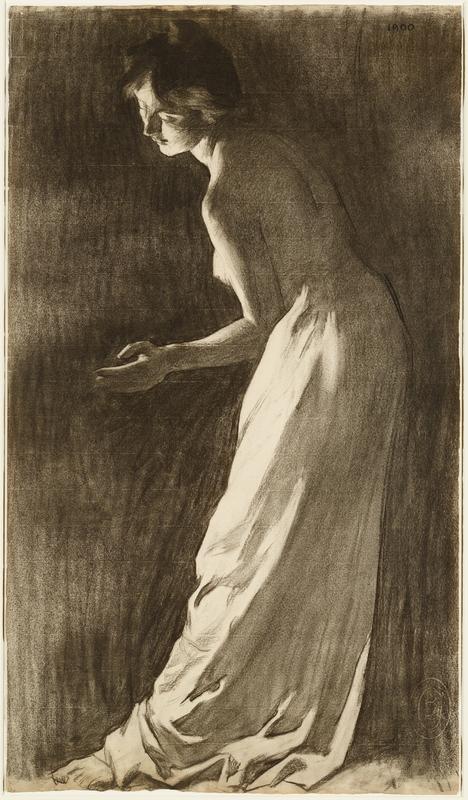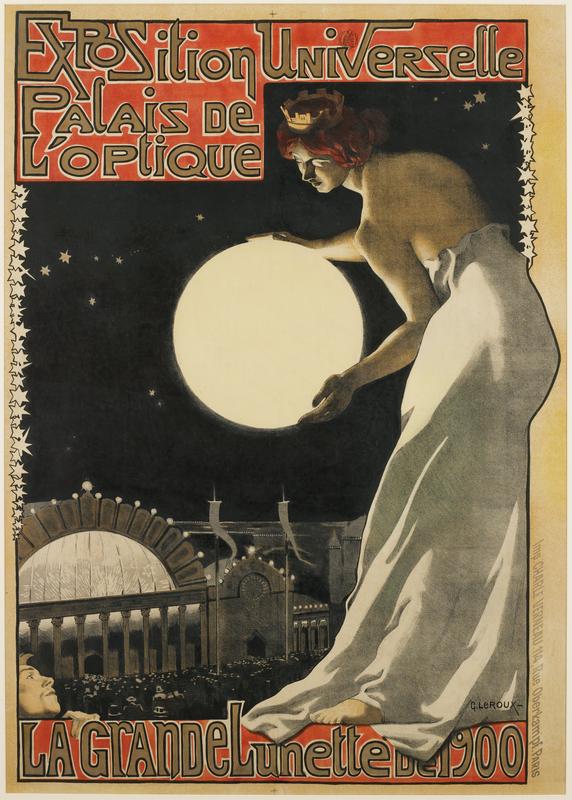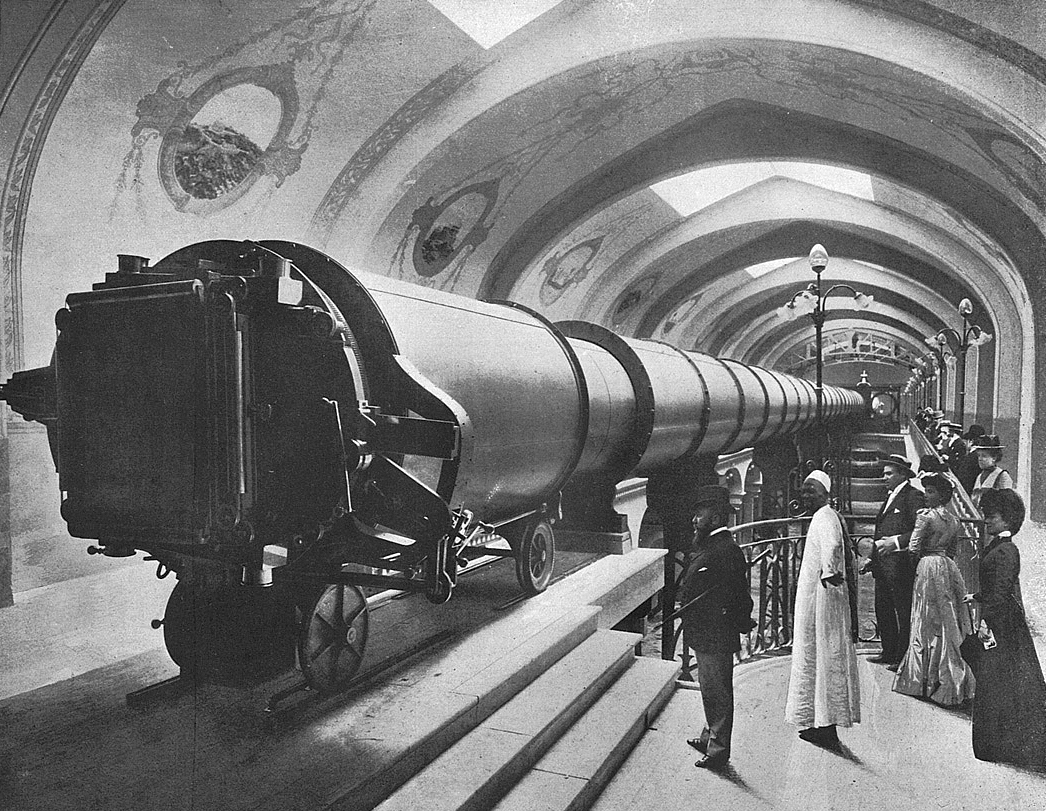

110–111. Georges Paul Leroux, Study for poster “Exposition Universelle–Palais de l’Optique La Grande lunette de 1900” and Exposition Universelle–Palais de l’Optique La Grande lunette de 1900
| Artist | Georges Paul Leroux, French, Paris 1877–Meudon (Paris) 1957 |
| Title, Date | Study for poster “Exposition Universelle-Palais de l’Optique La Grande lunette de 1900”, 1900 |
| Medium | Charcoal |
| Dimensions | 24 1/2 × 14 in. (62.2 × 35.6 cm) |
| Inscriptions + Marks | Watermark lower right: [oval] ?LV | Upper right: 1900 |
| Provenance | [Christine Bethenod, Paris, until 2007; to Weisberg]; Yvonne and Gabriel Weisberg, Minneapolis (2007–11; given to Mia) |
| Exhibition History | "A Means of Escape: European Posters from 1889 to 1930," Mia, 2011; "Reflections on Reality: Drawings and Paintings from the Weisberg Collection," Mia, 2022–23 |
| Credit Line | Gift of Gabriel P. and Yvonne M.L. Weisberg 2011.99 |
| Artist | Georges Paul Leroux, French, Paris 1877–Meudon (Paris) 1957 |
| Title, Date | Exposition Universelle-Palais de l’Optique La Grande lunette de 1900, 1900 |
| Medium | Color lithograph |
| Dimensions | 50 11/16 × 36 3/4 in. (128.7 × 93.3 cm) |
| Inscriptions + Marks | Lower right corner in black: G. LEROUX— | Printed at right edge in gray: Imp. CHARLE VERNEAU. 114, Rue Oberkampf. PARIS | Upper right above "Universelle": French Republic stamp in black |
| Provenance | [Librairie Elbé, Paris, until 2010; to Weisberg]; Yvonne and Gabriel Weisberg, Minneapolis (until 2010; given to Mia) |
| Exhibition History | "A Means of Escape: European Posters from 1889 to 1930," Mia, 2011; "Impressionism in the Age of Industry: Monet, Pissarro and More," Art Gallery of Ontario, Toronto, 2019; "Reflections on Reality: Drawings and Paintings from the Weisberg Collection," Mia, 2022–23 |
| Credit Line | Gift of Gabriel P. and Yvonne M.L. Weisberg, in honor of Lisa Michaux, for the Weisberg Collection at the MIA 2010.68 |
A top attraction at the 1900 Exposition Universelle in Paris was La Grande Lunette, a giant telescope in the Palais de l’Optique (Palace of Optics). Weighing 20 tons and extending 200 feet, the instrument was the largest refracting telescope ever built (fig. 1). Though impractical for ongoing scientific research, it could capture greatly magnified views of the moon. The invention was derided in the press but proved wildly popular with the public, and it contributed to the fair’s success.

While still in his early twenties, Georges Leroux received the commission to design the advertising poster for the lunette. The Weisbergs acquired both the finished poster and a splendid preparatory drawing, and donated both to Mia.
In the present drawing, Leroux appears to be working out the contours and lighting of the woman, seen here as a half nude gracefully leaning toward an unseen source of light. The dramatic shadows and highlights reflect Leroux’s recent training under Léon Bonnat (1833–1922) at the École des Beaux-Arts (School of Fine Arts) in Paris. Bonnat had often included brightly lit figures in his paintings and placed them against dark backgrounds. Here, Leroux used rough indications for the model’s facial features, fingers, and toes—and for the folds of the skirt. His measured application of soft charcoal on highly textured paper yielded a sensual softness throughout the image.
The finished poster, an Art Nouveau delight, reveals Leroux’s rationale for the woman’s pose: she is bending down to hold the luminous orb of the moon in her hands. Between the drawing and the final image, Leroux made several changes to the figure and rearranged the lighting on her now fuller skirt. In the published poster, she leans more emphatically, and her bottom extends into the right margin. We see her right arm, and her breast is now hidden. Leroux moved the knot of hair to the back of her head so that he could give her a crown.
Leroux made clear his seductive intention with the addition of a young man who looks longingly from the lower left corner. By lowering the moon toward him, the woman demonstrates how technology enables us to experience what once existed only in our dreams. With stars sparkling above the glowing Palais de l’Optique, Leroux set the stage for visitors to the fairgrounds—a place where the fantasies of technology and romance intertwine.
The poster served as Leroux’s public debut. The following year, in 1901, the artist initiated his regular participation in the Salon des Artistes Français. He won the prestigious Prix de Rome (Rome Prize) in 1906. He became a painter, muralist, tapestry designer, book illustrator, and, during World War I, a camouflage artist and producer of propaganda posters for the French government. The Weisberg Collection includes another work by Leroux, one that conveys the dynamism of Parisian street life (cat. no. 112). For his lifetime contributions to his country, he was named a knight of the Legion of Honor in 1926.
TER